For a couple of years, ZAL further develops the infrastructure for laser shock peening (LSP). The technology has already shown impressive results. The process creates residual stresses in the material which may lead to deformation of the part. LSP-generated residual stresses can enhance fatigue life, corrosion performance and improve damage tolerance of metal structures. Thus, experts can use this technique as a repair solution of aging plane fleets.
To evaluate LSP and 3D manufacturing, ZAL has enhanced its research toolbox with an incremental hole drilling system. It is one of the most accepted techniques for measuring depth-resolved residual stresses in metallic parts. The principle works like this: the expert drills a small hole in the material. It deforms the surface around the hole due to the redistribution of residual stresses. From the surface deformations measured by the strain gauges, one back-calculates the originally existing residual stresses.
The hole drilling method is well known for its robustness and low cost per measurement. It is simple and easy to prepare. The method is semi-destructive due to drilling of the hole in the part.
The engineers of ZAL equipped the hole drilling system with an optical table and a clamping system to measure residual stresses in parts with complex geometry. As a result, experts determine the stresses in industrial-scale parts (maximum size of 2m x 2m x 2m) in the lab. Moreover, the system is equipped with special clamping for measuring in the field. The hole drilling is portable and thus applicable for large immovable industrial components.





